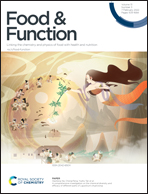Protective effects of chlorogenic acid on trimethyltin chloride-induced neurobehavioral dysfunctions in mice relying on the gut microbiota†
Abstract
Trimethyltin chloride (TMT) is acknowledged to have potent neurotoxicity. Chlorogenic acid (CGA), the most abundant polyphenol in the human diet, is well-known for its neuroprotective activity. This investigation was performed to determine the effects and mechanisms of CGA on TMT-induced neurobehavioral dysfunctions. Mice received oral administrations of CGA (30 mg kg−1) for 11 days, in which they were intraperitoneally injected with TMT (2.7 mg kg−1) once on the 8th day. The daily intake of CGA significantly alleviated TMT-induced epilepsy-like seizure and cognition impairment, ameliorating hippocampal neuronal degeneration and neuroinflammation. Oral gavage of CGA potentially exerted neuroprotective effects through JNK/c-Jun and TLR4/NFκB pathways. Microbiome analysis revealed that daily consumption of CGA raised the relative abundance of Lactobacillus in TMT-treated mice. SCFAs, the gut microbial metabolites associated with neuroprotection, were increased in the mouse hippocampus following CGA treatment. TMT-induced neurotransmitter disorders were regulated by oral gavage of CGA, especially DL-kynurenine and acetylcholine chloride. Additionally, neurotransmitters in the mouse hippocampus were found to be highly associated with the gut microbiota. Our findings provided research evidence for the neuroprotective effect of CGA on TMT-induced neurobehavioral dysfunctions.



 Please wait while we load your content...
Please wait while we load your content...